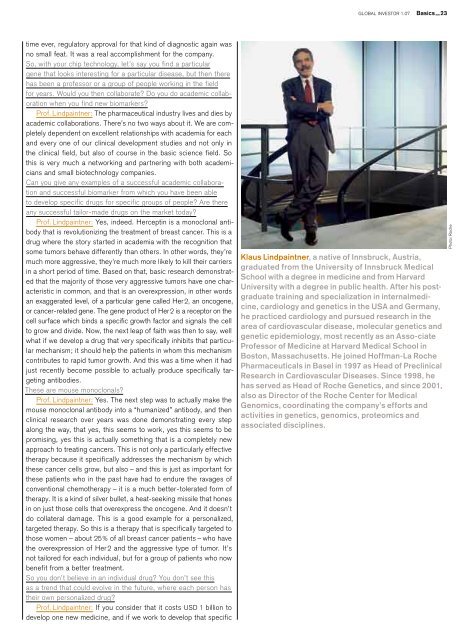Global families
Managing risks around cycles and supercycles Global Investor, 01/2007
Managing risks around cycles and supercycles
Global Investor, 01/2007
You also want an ePaper? Increase the reach of your titles
YUMPU automatically turns print PDFs into web optimized ePapers that Google loves.
GLOBAL INVESTOR 1.07 Basics — 23<br />
time ever, regulatory approval for that kind of diagnostic again was<br />
no small feat. It was a real accomplishment for the company.<br />
So, with your chip technology, let’s say you find a particular<br />
gene that looks interesting for a particular disease, but then there<br />
has been a professor or a group of people working in the field<br />
for years. Would you then collaborate? Do you do academic collaboration<br />
when you find new biomarkers?<br />
Prof. Lindpaintner: The pharmaceutical industry lives and dies by<br />
academic collaborations. There’s no two ways about it. We are completely<br />
dependent on excellent relationships with academia for each<br />
and every one of our clinical development studies and not only in<br />
the clinical field, but also of course in the basic science field. So<br />
this is very much a networking and partnering with both academicians<br />
and small biotechnology companies.<br />
Can you give any examples of a successful academic collaboration<br />
and successful biomarker from which you have been able<br />
to develop specific drugs for specific groups of people? Are there<br />
any successful tailor-made drugs on the market today?<br />
Prof. Lindpaintner: Yes, indeed. Herceptin is a monoclonal antibody<br />
that is revolutionizing the treatment of breast cancer. This is a<br />
drug where the story started in academia with the recognition that<br />
some tumors behave differently than others. In other words, they’re<br />
much more aggressive, they’re much more likely to kill their carriers<br />
in a short period of time. Based on that, basic research demonstrated<br />
that the majority of those very aggressive tumors have one characteristic<br />
in common, and that is an overexpression, in other words<br />
an exaggerated level, of a particular gene called Her 2, an oncogene,<br />
or cancer-related gene. The gene product of Her 2 is a receptor on the<br />
cell surface which binds a specific growth factor and signals the cell<br />
to grow and divide. Now, the next leap of faith was then to say, well<br />
what if we develop a drug that very specifically inhibits that particular<br />
mechanism; it should help the patients in whom this mechanism<br />
contributes to rapid tumor growth. And this was a time when it had<br />
just recently become possible to actually produce specifically targeting<br />
antibodies.<br />
These are mouse monoclonals?<br />
Prof. Lindpaintner: Yes. The next step was to actually make the<br />
mouse monoclonal antibody into a “humanized” antibody, and then<br />
clinical research over years was done demonstrating every step<br />
along the way, that yes, this seems to work, yes this seems to be<br />
promising, yes this is actually something that is a completely new<br />
approach to treating cancers. This is not only a particularly effective<br />
therapy because it specifically addresses the mechanism by which<br />
these cancer cells grow, but also – and this is just as important for<br />
these patients who in the past have had to endure the ravages of<br />
conventional chemotherapy – it is a much better-tolerated form of<br />
therapy. It is a kind of silver bullet, a heat-seeking missile that hones<br />
in on just those cells that overexpress the oncogene. And it doesn’t<br />
do collateral damage. This is a good example for a personalized,<br />
targeted therapy. So this is a therapy that is specifically targeted to<br />
those women – about 25% of all breast cancer patients – who have<br />
the overexpression of Her 2 and the aggressive type of tumor. It’s<br />
not tailored for each individual, but for a group of patients who now<br />
benefit from a better treatment.<br />
So you don’t believe in an individual drug? You don’t see this<br />
as a trend that could evolve in the future, where each person has<br />
their own personalized drug?<br />
Prof. Lindpaintner: If you consider that it costs USD 1 billion to<br />
develop one new medicine, and if we work to develop that specific<br />
Klaus Lindpaintner, a native of Innsbruck, Austria,<br />
graduated from the University of Innsbruck Medical<br />
School with a degree in medicine and from Harvard<br />
University with a degree in public health. After his postgraduate<br />
training and specialization in internalmedicine,<br />
cardiology and genetics in the USA and Germany,<br />
he practiced cardiology and pursued research in the<br />
area of cardiovascular disease, molecular genetics and<br />
genetic epidemiology, most recently as an Asso-ciate<br />
Professor of Medicine at Harvard Medical School in<br />
Boston, Massachusetts. He joined Hoffman-La Roche<br />
Pharmaceuticals in Basel in 1997 as Head of Preclinical<br />
Research in Cardiovascular Diseases. Since 1998, he<br />
has served as Head of Roche Genetics, and since 2001,<br />
also as Director of the Roche Center for Medical<br />
Genomics, coordinating the company’s efforts and<br />
activities in genetics, genomics, proteomics and<br />
associated disciplines.<br />
Photo: Roche

















